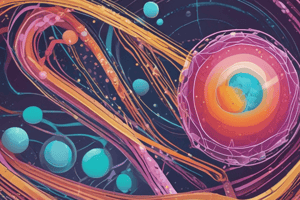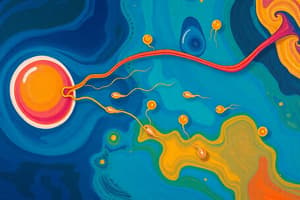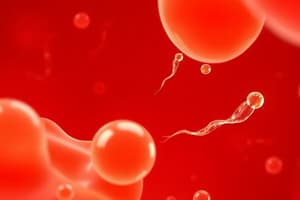Podcast
Questions and Answers
What occurs immediately following the penetration of a sperm into the oocyte?
What occurs immediately following the penetration of a sperm into the oocyte?
Which mechanism is primarily responsible for the rapid prevention of polyspermy immediately after fertilization?
Which mechanism is primarily responsible for the rapid prevention of polyspermy immediately after fertilization?
During what stage does the zygote undergo rapid mitotic divisions without growth?
During what stage does the zygote undergo rapid mitotic divisions without growth?
What can result from polyspermy in the fertilization process?
What can result from polyspermy in the fertilization process?
Signup and view all the answers
After fertilization, which structure is formed following cleavage and before becoming a blastocyst?
After fertilization, which structure is formed following cleavage and before becoming a blastocyst?
Signup and view all the answers
Study Notes
Fertilization Process
- Sperm Migration: Sperm travel through the female reproductive tract, guided by chemical signals from the egg. Only a small percentage reach the oocyte.
- Capacitation: Sperm undergo changes in the female reproductive tract, becoming capable of penetrating the egg. This increases sperm motility and prepares them for acrosomal reaction.
- Zona Pellucida Binding: Sperm binds to receptors (ZP3) on the zona pellucida, a glycoprotein layer surrounding the egg.
- Acrosomal Reaction: Sperm release enzymes from the acrosome to break down the zona pellucida, allowing sperm to penetrate.
- Fusion of Sperm and Egg Membranes: Sperm fuses with the oocyte's membrane (oolemma), allowing the sperm's nucleus to enter the oocyte cytoplasm.
- Cortical Reaction: The oocyte releases enzymes to prevent multiple sperm from fertilizing the egg. This modifies the zona pellucida, making it impermeable to other sperm.
- Completion of Meiosis II: The oocyte completes meiosis II, forming a mature ovum and a polar body. This occurs after sperm penetration.
- Activation of the Oocyte: Sperm entry triggers a cascade of biochemical and structural changes in the oocyte, including a calcium wave that spreads throughout the cytoplasm.
Prevention of Polyspermy
- Fast Block: Immediately after sperm entry, the oocyte's membrane depolarizes, preventing other sperm from fusing.
- Slow Block: The cortical reaction (release of cortical granules) hardens the zona pellucida, making it impermeable to other sperm. This is a longer-lasting response than the fast block.
Formation of the Zygote
- Pronuclei Fusion: The sperm and egg nuclei (pronuclei) fuse, combining their genetic material to form a zygote.
- Cleavage: Rapid mitotic cell divisions of the zygote without growth, forming a multicellular structure.
Blastocyst Formation
- Cavitation: A fluid-filled cavity (blastocoel) forms within the morula (early embryo), transforming it into a blastocyst.
- Blastocyst Structure: The blastocyst has two main cell types: Inner Cell Mass (ICM - embryo) and Trophoblast (placenta).
- Zona Pellucida Disappearance: The zona pellucida disintegrates, allowing implantation in the uterine wall.
Clinical Relevance and Key Points
- Genetic Diversity: Fertilization ensures genetic diversity.
- Cleavage: Prepares the zygote for implantation.
- Implantation: Requires successful blastocyst formation and removal of the zona pellucida to attach to the uterine wall.
Studying That Suits You
Use AI to generate personalized quizzes and flashcards to suit your learning preferences.
Related Documents
Description
Test your knowledge on the steps involved in the fertilization process. This quiz covers sperm migration, capacitation, zona pellucida binding, and the acrosomal reaction. Evaluate your understanding of how sperm and egg interact from the initial encounter to the completion of fertilization.




